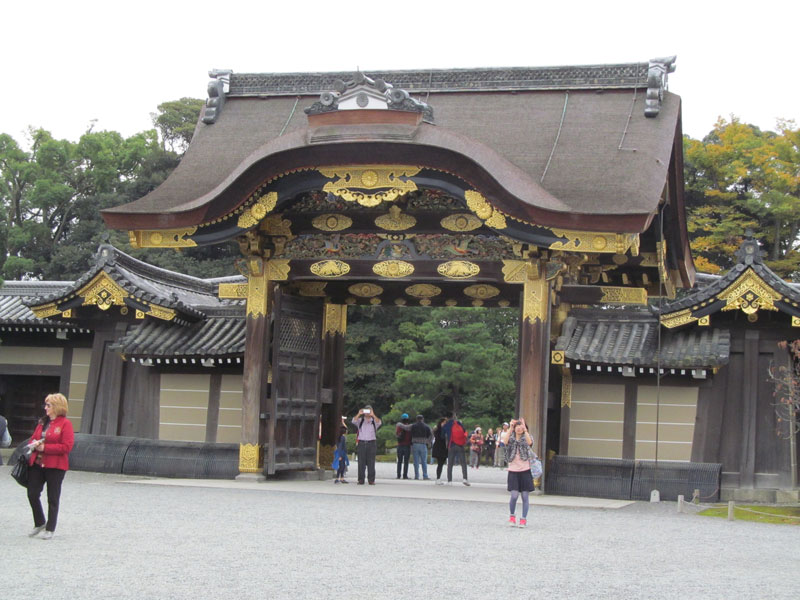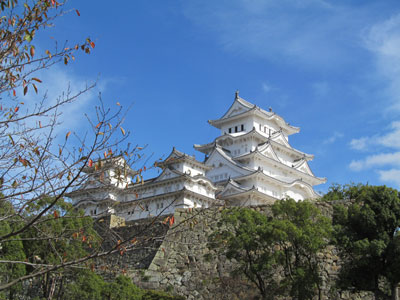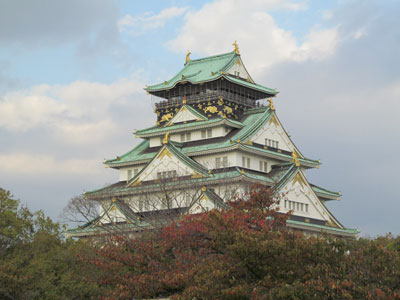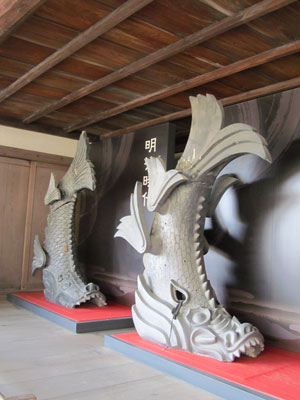A tale of three castles
This item appears on page 54 of the July 2016 issue.
The three castles I visited on my trip to Japan in October-November 2015 — Osaka, Nijo and Himeji — have much in common. Each is a spacious complex in the middle of a large city. Each is surrounded by a moat and by expansive gardens. Each displays monumental gateways, picturesque wall turrets and impressive stonework. Two of the three castles still each have their tenshu, a central tower or keep.
These castle complexes are so grand that they could be mistaken for imperial residences, but they are not. Each was built by a powerful military leader, either a shogun or a kampaku, who was, in some ways, more powerful than the emperor. The castles these leaders built stood as concrete embodiments of their prestige and power.
Osaka Castle
Osaka Castle is located in the middle of one of Japan’s largest cities. Occupying the site of a temple destroyed by a previous samurai warlord, the castle was begun by Toyotomi Hideyoshi in 1583. The castle he constructed was meant to stand at the center of a Japan unified under his rule.
Toyotomi never held the title of shogun. Already a daimyo, or feudal baron, he gave himself the title of kampaku, or imperial counselor. In reality, he was the de facto ruler of Japan, although he was theoretically appointed by the emperor.
That power was, however, short-lived. Toyotomi died in 1598. Soon after, Tokugawa Ieyasu declared himself shogun and attacked Osaka Castle, which finally fell in 1615 after a long siege.
The main tower was rebuilt by Tokugawa’s heir. Destroyed again in 1665 — this time by lightning — the tower was rebuilt once again in 1931, 266 years after its second destruction. It is this tower, a prominent landmark of the city, which visitors see today.
The castle complex is huge. Surrounding the main tower are moats and gardens, and within these are gateways, turrets, storehouses and magazines, all parts of the fortifications.
The stone walls are especially impressive, including some enormous stones that have acquired names of their own, such as the 130-ton Tako-ishi (Octopus Stone) just past the Sakura Gate, one of the monumental gateways. Nearby are the 52-ton Dragon Stone and the 40-ton Tiger Stone.
The main tower is now an excellent museum, with each of its floors dedicated to the castle’s history and its occupants. A cleverly designed display presents 19 scenes from the life of the castle’s founder, Toyotomi Hideyoshi.
There are also models of the castle; a tanka, a 31-syllable poem composed by Toyotomi, and large folding screens graphically depicting pivotal battles fought at Osaka Castle in 1614 just before its fall.
Osaka Castle (www.osakacastle.net) is open daily, 9 to 4:30. Admission costs ¥600 (near $5.50).
Nijo Castle
Nijo Castle is located in Kyoto, which was Japan’s capital for over a thousand years, from 794 to 1868. This was where the imperial court was located and also where the shogun Tokugawa Ieyasu chose to build a castle to keep an eye on the emperor. It is no surprise that Nijo Castle and the imperial palace are located only 1.3 miles from each other.
Tokugawa Ieyasu, another of Japan’s great unifiers, completed construction of his castle in 1603. One of his successors, Tokugawa Iemitsu, greatly expanded the castle in 1626.
An outer moat encloses the ninomaru, or outer area, where storehouses once held provisions and weapons. A second moat beyond this encloses the honmaru, which was the center of the castle complex, where government offices, the shogun’s residence and the tenshu, or main tower, were once located. The honmaru was the heart of the castle.
Unfortunately, the main tower was destroyed by fire in 1750 and has never been rebuilt. The series of buildings in the ninomaru not only displays paintings of trees (willows, pines, maples and cherry, among others) and wild animals (tigers and leopards predominate) but gives a good idea, through the arrangement of the many rooms, of how the shogun’s court functioned.
There is an orderly progression, leading from waiting rooms to formal reception rooms to inner audience chambers. One of the rooms, the Ohiroma, was where the 15th Tokugawa shogun, Tokugawa Yoshinobu, announced the restoration of imperial rule in 1867 (the actual restoration occurred the following year), ending the 264-year-long Tokugawa shogunate.
The Nijo gardens are beautiful in any season. At the Warakuan Teahouse, on the east side of the castle complex, visitors can sample the powdered green tea called matcha while contemplating serene Seiryuen Garden. Also not to be missed is the 400th Anniversary Gallery, displaying original paintings from the castle. Nijo Castle is included in the UNESCO World Heritage Sites list.
Nijo Castle (www.city.kyoto.jp/bunshi/nijojo) is usually open daily, 8:45 to 4. However, it is closed on Tuesdays in January, July, August and December and is also closed from Dec. 26 to Jan. 4. Admission costs ¥600.
I especially recommend pairing a visit to Nijo Castle with a visit to the Kyoto Imperial Palace (preferably not on the same day) to note similarities and differences between the shogun’s and the emperor’s palaces.
A visit to the Imperial Palace must be booked through the Imperial Household Agency. This can be done online in advance of a trip by going to http://sankan.kunaicho.go.jp/english/index.html. There are set times for English-speaking tours. There is no admission charge for the Imperial Palace.
Himeji Castle
“Awesome” is a word that is used so liberally nowadays that it has almost lost its meaning. However, it could be correctly applied to Himeji Castle. I’ve visited this castle four times over the years and I am still in awe.
Himeji Castle, like Osaka Castle and Nijo Castle, is located within a large city, Himeji. It, too, has a ninomaru, outer area, and a honmaru, inner area, both enclosed by gates, turrets, stone walls and gardens. Dominating the honmaru is the tenshu. Plastered in white, the tower is called the White Egret because of its resemblance to an egret about to take flight.
However, unlike Osaka and Nijo, both dating from the late 16th or early 17th centuries, Himeji dates back much further to when a fort was constructed on the site in 1333 by a samurai warrior. The samurai’s son built a castle a few years later.
After successive remodelings in the 14th to 16th centuries, Toyotomi Hideyoshi remodeled the castle once again in 1581, building the main tower. After his death, the castle became Tokugawa property and was given in 1600 by Tokugawa Ieyasu to his son-in-law. For the next 271 years, ownership of the castle shifted from one warlord to another until the castle was finally abandoned in 1871. It was later purchased by a Himeji resident for about $2,000.
The tenshu finally reopened in 2015 after a lengthy restoration. It and the surrounding buildings form, as one critic put it, one of the “finest surviving examples of early-17th-century Japanese castle architecture.”
The inside of the tenshu is bare, unlike at Osaka Castle — all the better to admire the superb woodwork throughout plus the variety of defensive features, such as the loopholes in the shapes of circles, triangles and rectangles, used as openings for arrows and guns, and the concealed stone drops for raining rocks down on invaders.
Himeji Castle is a UNESCO World Heritage Site.
Next door to Himeji Castle is Kokoen Garden, which shouldn’t be missed. There are different types of gardens to stroll through within Kokoen Garden, and there’s a good restaurant on the grounds, with views of the gardens and waterfalls.
Himeji Castle (www.himejicastle.jp) is open daily from 9 to 5 from May to August and 9 to 4 September to April; it’s closed on Dec. 29 and 30. Admission to the castle costs ¥1,000 (about $9) or to the castle and garden, ¥1,040.
If you go…
In Osaka, my husband, Paul, and I “recuperated” at the New Otani Hotel (www.newotani.co.jp/en/osaka) for four nights after our 26-hour door-to-door journey from New York. Our suite with separate living room and bedroom overlooked Osaka Castle, beautifully lit at night. The New Otani has so many great restaurants that we never left the hotel to dine elsewhere. Our favorite was Keyaki, a teppanyaki restaurant offering Kobe steaks.
On almost every one of our trips to Kyoto, we’ve stayed at the Hyatt Regency Hotel (www.kyoto.regency.hyatt.com), which offers spacious rooms, many of which overlook lovely interior gardens.
There is a great selection of restaurants in the hotel. Our favorite is The Grill. Paul and I enjoyed one of the best Thanksgiving Day dinners we’ve ever had in The Grill. We requested it way in advance of our trip, and the chef delivered superbly.
We did not stay in Himeji. We traveled by shinkansen (bullet train) from Kyoto, a journey of only 45 minutes.




